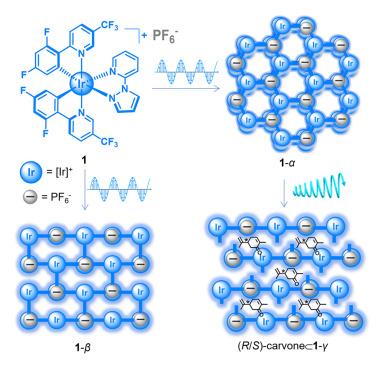金属配体-阴离子框架:可调偏振发光和晶体间转化
IF 17.5
1区 材料科学
Q1 MATERIALS SCIENCE, MULTIDISCIPLINARY
引用次数: 0
摘要
非共价有机框架(NCOFs)是由多种分子间相互作用构建而成的多孔材料。要获得具有可调孔隙和高性能偏振发光的多晶态 NCOFs 是一项挑战。本文基于层内 F-H 氢键和层间阳离子-阴离子静电相互作用,从铱配合物 1 中提出了两种多形态有机金属 NCOFs:1-α 和 1-β。这些金属配位体-阴离子框架显示出线性偏振蓝色磷光,偏振度高达 0.91,并具有光波导特性。掺杂了钌受体的 1-α 微晶对 Et2O 蒸汽具有可逆反应,显示出调制能量转移和偏振发光。通过掺入手性(R/S)-卡酮客体,1-α 和 1-β 微晶转变成了另一种多晶型 1-γ 晶体,从而产生了不对称系数约为 0.1 的可调圆偏振发光。这项工作为获得多态 NCOFs 提供了一个独特的概念,在多功能光学和光电应用方面展示了突出的潜力。本文章由计算机程序翻译,如有差异,请以英文原文为准。


Metalloligand-anion frameworks: Tunable polarized luminescence and crystal-to-crystal transformation
Noncovalent organic frameworks (NCOFs) are porous materials constructed by diverse intermolecular interactions. It is challenging to obtain polymorphic NCOFs with adjustable pores and high-performance polarized luminescence. Here, two polymorphic organometallic NCOFs, 1-α and 1-β, are presented from an iridium complex 1 based on the intralayer F···H hydrogen bonding and interlayer cation-anion electrostatic interactions. These metalloligand-anion frameworks display linearly polarized blue phosphorescence with a polarization degree of up to 0.91 and optical waveguide properties. The 1-α microcrystals doped with a ruthenium acceptor manifest a reversible response to Et2O vapor, showing modulated energy transfer and polarized luminescence. The 1-α and 1-β microcrystals are transformed into another polymorphic 1-γ crystal by incorporating chiral (R/S)-carvone guests, affording tunable circularly polarized luminescence with a dissymmetry factor of around 0.1. This work provides a unique concept to obtain polymorphic NCOFs, demonstrating prominent potential in multifunctional optical and chiroptical applications.
求助全文
通过发布文献求助,成功后即可免费获取论文全文。
去求助
来源期刊

Matter
MATERIALS SCIENCE, MULTIDISCIPLINARY-
CiteScore
26.30
自引率
2.60%
发文量
367
期刊介绍:
Matter, a monthly journal affiliated with Cell, spans the broad field of materials science from nano to macro levels,covering fundamentals to applications. Embracing groundbreaking technologies,it includes full-length research articles,reviews, perspectives,previews, opinions, personnel stories, and general editorial content.
Matter aims to be the primary resource for researchers in academia and industry, inspiring the next generation of materials scientists.
 求助内容:
求助内容: 应助结果提醒方式:
应助结果提醒方式:


